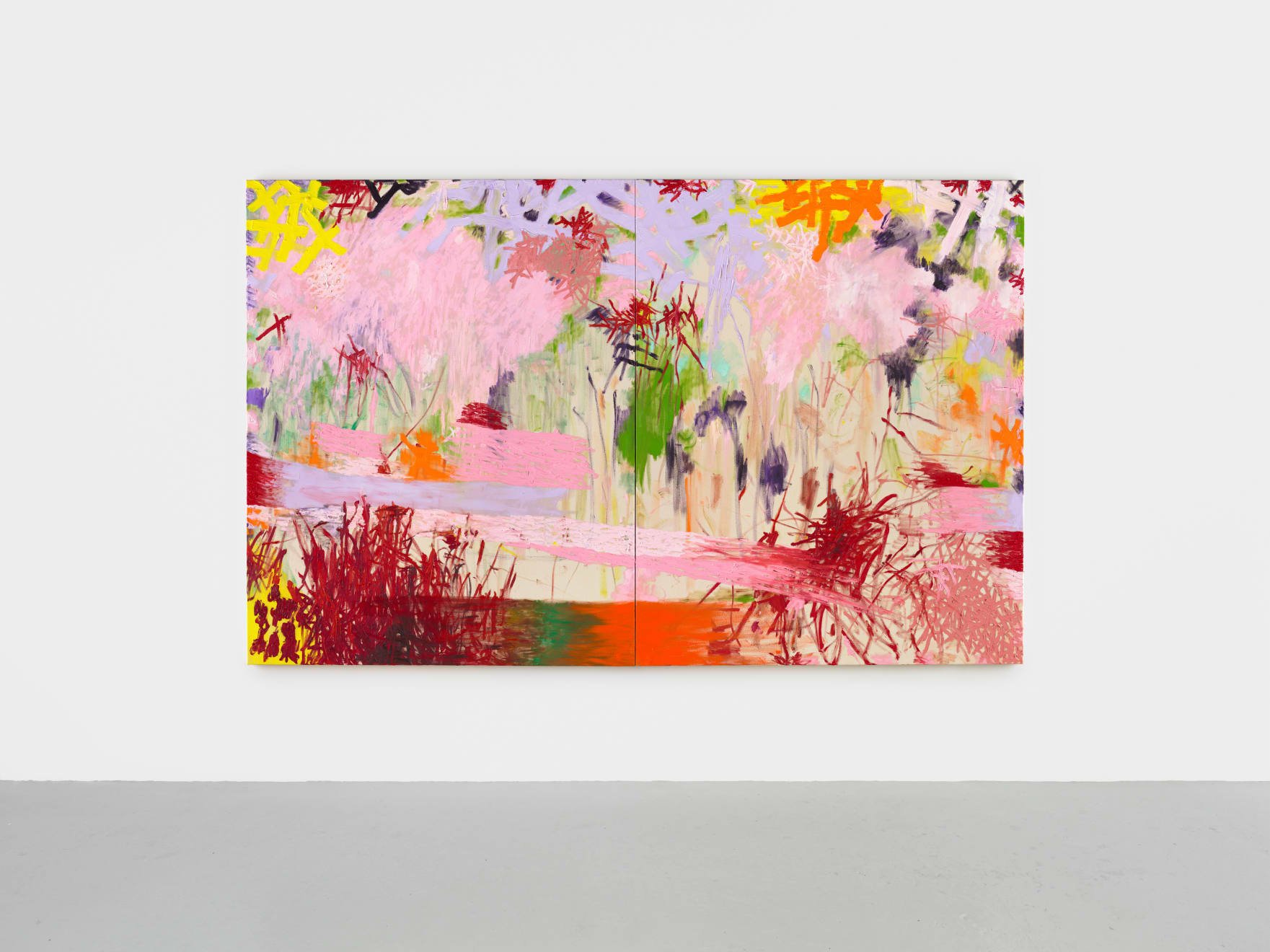Sim Smith is proud to present I see you in everyone I love, Daisy Parris' second solo exhibition with the gallery. The exhibition journeys through painterly storms across works in hugely varying scales, in an exploration of fears, anxieties and emotions felt by us all at one stage or another; grief, loss, agony, potential and hope.
It is Parris' world, whether exogenous of endogenous; that of the feeling left by landscapes journeyed through or the marks left by psychological scars, or the space in which hope lives, that we see referenced in highly personal ways. It is these remembered, lived through emotional states that create what we see on the canvas.
Visual memories are paired with Parris' interest in colour theory and its powerful influence over human behaviour. This is seen across all paintings in this exhibition but none more so than in the largest pieces in the show, spanning 4 meters wide. Spread across multiple panels set side by side, Parris' red and pink marks sprawl and seek, working through and searching. These lush, dense tangles delicately balance despair and dreams; assertive yet timid, brutal yet tender, sombre yet savage. Surface and composition are key to Parris who studies rhythmic contrasting lines in the paintings and layered fields of colour which act as psychological triggers; downpours and elevations by brushstrokes that cannot but impact our emotions.
The relationship between colours and weight of brushstroke have expanded into collage and poetry in this show, all equal and component parts which Parris uses to construct their paintings. Poems are poems in this exhibition but also colour, texture and surface. The texts in Parris' works allude to poems they have not yet written or don't believe they have the skill to write, they are suggestions of potential poems and within them encapsulate a state of potential and also a fear of failure. Poems are organised onto the canvas based on their physical properties. Parris treats the texts as scraps, otherwise fears they would not be able to share them. They become potent visual rhythms, the same as Parris' painterly gestures:
"This comes across in the way I use paint and brush strokes as well - dry paint dragged across the surface, causing incomplete or frantic blocks of colour - even though it is my intention to create solid blocks of colour - my intention just fizzles away as I give over to the properties and potential of the paint."
They do afford them however, a moment of reflection. The title of the show is a phrase that has been used again and again by Parris across multiple works over many years, a vernacular that speaks to their interest in extremes and exploring sentiments at opposite end of the spectrum. Parris wants the works to intersperse everything that is important and everything that is meaningless. The obsessive, whether in gesture, rhythm or behaviour is the space in which Parris inhabits as a painter. Square scraps of canvas stuck onto the paintings symbolise old photographs, letters, used tissues or receipts. Parris works as an accumulator of it all, sensations and impressions associated with the meaningful and the inconsequential. Their work survives in this space of extreme feeling and Parris survives because of it.
"In this show I am exploring my greatest fears and anxieties but there is also a lightness to it as I float in and out of agony and hope. I am interested in these extremes."
The reactions their paintings impart cannot be verbalised appropriately; primal and instinctive, Parris possesses a proficiency of infusing colour with mood and mark making with sensation. Parris strips away the routine of lived experience in their works and leaves us only with a distilled, potent feeling fixed to a moment or experience across a period of time. The exhibition delves deeply into loss and grief but also looks to potential and hope - continuing their fascination with the extreme, the opposite and the ultimate; a space where, as a painter, Parris has set up home.
Poetry has the capacity - to quote Adrienne Rich - 'to play around with the notion that day might be night, love might be hate; nothing can be too sacred for the imagination to turn into opposite or to call experimentally by another name. For writing is renaming." There is a poetic tension at the heart of Daisy Parris' work: both viscerally raw and intuitively emotive, it dwells between experience and language, the unknown and known. This poetics of individual and collective experience is tenderly executed in Parris' solo show I see you in everyone I love, where the loss of another transforms into a gesture of tactical hope.
Parris does not shy away from leaning into the complexity and difficulties of the past and present and how they float together and intersect. Even the titles of the works explore these memories of relationality: ' A Storm Inside You'; 'Sorry Three Times' and 'A Storm the Night You Went' each the ebbing and flowing of feelings and time. These linguistic gestures create the complex web of abstract yearning, tenderness, and starkness, all of which are woven within these abstractions of alchemy through the prism of mourning.
Yet there is always a thread of emotional potency and unpredictability in the abstract formations - found in the raw marks and bold, unruly brush strokes which generate a sense of clarity and integrity. 'The Light' allows the viewer to experience Parris' depiction of hope in a diluted, purer form: one where the vibrations and rough marks of pink appear woven over a red vexed underlay. There is a sense of searching and attention to language which feels indicative of unfinished pasts and presents, where future poems are only gestured towards a potential becoming, yet remain not fully formed.
In similar measure, grief can open onto terrains of catharsis, this duality is perhaps the most potent of Parris' adorning brushstrokes. Collective experience is also made apparent through fragmentary phrases. Titles such as 'Sadness Comes and Goes Throughout the Day' encapsulate the rhythm and longevity of life's complex tapestry of emotion, where a sense of temporality is familiar; tepid. In this way, each painting acts as a proposition to the viewer and the artist, a communal sense of grief and uncertainty, despite the paintings being profoundly visceral and personal.
The fine balancing of lived mourning, between death and life brings Parris' work an eternal freshness and veracity. It is with this charged conviction of relationality, where brushstrokes are both rough and raw, tender and pensive. As viewers, we are asked to look; we are invited to meditate upon the rugged woven tapestry of life, for all its charged complexities of grief, hope and grieving.
- Hatty Nestor, January 2022
Hatty Nestor is a cultural critic and writer, published in Frieze, The Times Literary Supplement, Granta, The White Review and other publications. Ethical Portraits (2021) is published with Zero Books.



